The Step IT Up recruiting programme, a collaborative effort between UST and its clients, typically Fortune 1000 companies, trains women, minorities, and veterans interested in the IT industry.
The programme is integrated into the UST bid for IT services and is often seen as a differentiating reason for winning business.
While companies trust UST to provide quality IT services, they are also motivated by creating a diverse talent pipeline that allows them to hire between 12 to 50 diverse IT employees after one year of working for UST on their projects. Through the programme, 87% of their talent is hired by clients, and 92% of graduates remain with them for 3+ years.
Olywn DePutron, the director of Step IT Up, speaks with DiversityQ.
Olywn, can you tell us more about the UST Step IT Up programme and its mission?
Our mission with the UST Step IT Up programme is to recruit and train women, individuals from minority communities and other underrepresented groups, as well as service veterans to help them enter the tech world.
Organisations worldwide are facing a shortage of skilled workers, with more vacant IT jobs than qualified professionals ready and prepared for those roles. UST Step IT Up’s intensive apprenticeship program is a brilliant solution for the IT talent shortage that makes a meaningful difference.
What kind of training and resources does the programme offer to its participants?
The training is based on our client’s requirements and the specific skill set they are looking for, whether that’s a cybersecurity analyst, scrum master, python developer or project manager.
The training programme is quite rigorous; it’s eight hours a day, Monday through Friday, for four to seven months. In addition to IT training, we also work on soft skills to help participants develop their communication skills. After the candidates graduate, they are placed on-site with the clients for about a year but are still full-time employees of UST.
How has the programme helped to increase diversity in the IT industry?
UST Step IT Up has no borders. The program is active in Europe, Latin America, and Australia, and there is a version of it in Asia as well. Diversity is defined differently by different organisations and countries, so we consider and match our recruiting efforts depending on the client.
Can you share any success stories or notable achievements of programme participants?
One inspiring example is Brandon Cooley, a black UST Step IT Up graduate who didn’t have tech experience before entering the programme. Since graduating five years ago, Brandon has been in cybersecurity. He has said that UST Step IT Up provided him with the tools necessary to build a strong knowledge of cybersecurity and allowed him to self-teach and develop soft skills.
In addition, we trained 12 veterans for STEM roles with a client through the UST Step IT Up programme. After 100 days of training, the group graduated and now supports Fiserv onsite. This graduation was a monumental occasion celebrating our veteran graduates with a client that genuinely supports veterans and the veteran community.
How does the programme address challenges faced by women, minorities, and veterans in the tech industry?
It is widely recognised that there is a small percentage of women, minorities and veterans currently working in leading STEM roles. For example, in the US, only 28% of STEM jobs are held by women. Our programme encourages women to look at careers in technology and helps address this gender imbalance. UST Step IT Up allows women and other underrepresented groups to be equipped with the knowledge and tools needed to start a potential career in tech.
One way UST promotes STEM careers is by working with women at technology events and with programmes specifically made for women – such as a bank in Atlanta that put 21 women through a specialist RPA training programme. The bank was previously outsourcing this work to an offshore company, and after just six six months on the job post-graduation, these women picked up most of the offshore roles.
How does Step IT Up keep up with diversity trends in the tech industry and adjust its approach accordingly?
We attend DEI conferences. We apply what we learn and adjust accordingly.
Can you discuss the future goals of the programme and how it plans to continue to support diversity and inclusion in the IT field?
We continue to spread the message that technology is open to all and that the rewards in this field are great. It does not require a computer science degree to enter this exciting field, and we search for diverse candidates that are willing to do what it takes to learn. In addition to the UST Step IT Up programme, we are starting a DEI practice to assist and support our clients with their DEI initiatives.
How does the programme collaborate with tech companies and organisations to create job opportunities for its participants?
During the selection process, candidates will be interviewed by UST and the client. The clients are involved in the interview process, so they can select and see if their personalities are a good fit for their organisation. Once the candidates are chosen, they will receive an offer letter from UST and then move on to training. After four to seven months of training, the students are placed on-site for about a year with the client, but they remain full-time employees of UST. During this time, the client has a chance to evaluate their work. Out of those working on-site with a client, 87% get a direct offer.
Can you speak to the impact of the programme on the tech industry as a whole?
UST Step IT Up is a free programme, making it accessible to a wide pool of candidates and has been considered equivalent to a college degree. Clients who have become involved with Step IT Up tend to be large organisations included in the Fortune 500. They come from a wide range of verticals and geographies, highlighting the global need for talent and the recognition that this is a fantastic opportunity. The program is also creating opportunities for more minorities and more women in tech roles, helping our clients make an impact not only on their businesses but on the communities they serve.
How can individuals and organisations support or get involved with the Step IT Up program?
Any organisation can contact UST to help solve their skills shortages by participating in UST Step IT Up. You do not have to be a customer of UST to take advantage of this inspirational programme. Simply search for UST Step IT Up or contact Olwyn DePutron directly, and I will walk you through the process.









